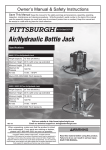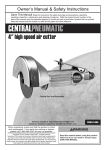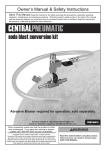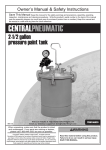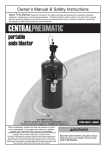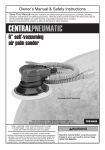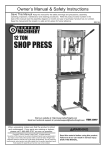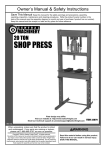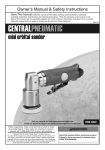Download Harbor Freight Tools 12 ton Air/Hydraulic Bottle Jack Product manual
Transcript
Table of Contents Safety��������������������������������������������������������� 2 Maintenancei���������������������������������������������� 10 Setup........................................................... 4 Parts List and Diagram............................... 14 Operationa���������������������������������������������������� 8 Warranty..................................................... 16 Safety WARNING SYMBOLS AND DEFINITIONS This is the safety alert symbol. It is used to alert you to potential personal injury hazards. Obey all safety messages that follow this symbol to avoid possible injury or death. Indicates a hazardous situation which, if not avoided, will result in death or serious injury. Setup Indicates a hazardous situation which, if not avoided, could result in death or serious injury. Indicates a hazardous situation which, if not avoided, could result in minor or moderate injury. Addresses practices not related to personal injury. Operation IMPORTANT SAFETY INSTRUCTIONS 1. Study, understand, and follow all instructions before operating this device. 14. Apply parking brake and chock tires before lifting vehicle. 2. Do not exceed rated capacity. 15. Lift vehicle only at manufacturer recommended locations. 3. Use only on hard, level surfaces. 4. Lifting device only. Immediately after lifting, support the vehicle with appropriate means. 5. Do not move or dolly the vehicle while on the jack. 6. Failure to heed these markings may result in personal injury and/or property damage. 7. Lift only areas of the vehicle as specified by the vehicle manufacturer. Maintenance 8. No alterations shall be made to this product. 9. Never work on, under or around a load supported only by this device. 10. Do not adjust safety valve. 11. Wear ANSI-approved safety goggles and heavy-duty work gloves during use. 12. Keep clear of load while lifting and lowering. 13. Lower load slowly. Page 2 16. Inspect before every use; do not use if parts are loose or damaged. 17. Do not use for aircraft purposes. 18. The warnings, precautions, and instructions discussed in this manual cannot cover all possible conditions and situations that may occur. The operator must understand that common sense and caution are factors, which cannot be built into this product, but must be supplied by the operator. 19. The brass components of this product contain lead, a chemical known to the State of California to cause cancer, birth defects (or other reproductive harm). (California Health & Safety Code § 25249.5, et seq.) IMPORTANT! Before first use: Check hydraulic fluid level and fill to 1/4″ below the fill port as needed. Thoroughly test the Jack for proper operation. If it does not work properly, bleed air from its hydraulic system as stated in Bleeding Instructions on page 5. For technical questions, please call 1-888-866-5797. Item 61382 1. Never connect to an air source that is capable of exceeding 200 psi. Over pressurizing the tool may cause bursting, abnormal operation, breakage of the tool or serious injury to persons. Use only clean, dry, regulated compressed air at the rated pressure or within the rated pressure range as marked on the tool. Always verify prior to using the tool that the air source has been adjusted to the rated air pressure or within the rated air-pressure range. 2. Never use oxygen, carbon dioxide, combustible gases or any bottled gas as an air source for the tool. Such gases are capable of explosion and serious injury to persons. Safety Air Source Symbol Definitions PSI Property or statement Pounds per square inch of pressure CFM Cubic Feet per Minute flow SCFM Cubic Feet per Minute flow at standard conditions NPT National pipe thread, tapered Symbol Property or statement WARNING marking concerning Risk of Eye Injury. Wear ANSI‑approved eye protection. WARNING marking concerning Risk of Hearing Loss. Wear hearing protection. WARNING marking concerning Risk of Respiratory Injury. Wear NIOSH‑approved dust mask/respirator. Setup Symbol WARNING marking concerning Risk of Explosion. Maintenance Operation SAVE THESE INSTRUCTIONS. Item 61382 For technical questions, please call 1-888-866-5797. Page 3 Initial Tool Set Up Read the ENTIRE IMPORTANT SAFETY INSTRUCTIONS section at the beginning of this manual including all text under subheadings therein before set up or use of this product. Safety Components and Controls Saddle Setup Fill Plug Operation Fulcrum Carrying Handle Jack Handle Maintenance Release Valve Air Lever Air Lever Lock Air Inlet Figure A Page 4 For technical questions, please call 1-888-866-5797. Item 61382 Bleeding Instructions Before each use or if Jack performance decreases, check for excessive air and proper hydraulic fluid level in Jack. If Jack appears not to be working properly, it may be necessary to purge its hydraulic system of excessive air as follows: 5. Check fluid level and, if necessary, top off with hydraulic fluid. 2. Remove Fill Plug. Fill with hydraulic fluid (sold separately) to full level, if necessary. 6. Close the Release Valve by turning it clockwise, then replace Fill Plug. 3. Place the slotted end of the Jack Handle over the Release Valve, then turn counterclockwise to open the Release Valve. IMPORTANT: After bleeding the Jack, test the Jack for proper operation prior to its actual use. 4. Insert the Jack Handle into the Fulcrum, apply downward pressure to the Saddle, then pump the Jack Handle quickly several times. Safety 1. Assemble the Jack Handle by pushing the two sections together. 7. If, after bleeding, the Jack does not appear to be working properly, do not use it until repaired by a qualified service technician. TO PREVENT SERIOUS INJURY FROM EXPLOSION: Use only clean, dry, regulated, compressed air to power this tool. Do not use oxygen, carbon dioxide, combustible gases, or any other bottled gas as a power source for this tool. 2. Attach an air hose (not included) to the compressor’s air outlet. Connect the air hose to the Jack’s Air Inlet. Other components, such as a connector and quick coupler, will make operation more efficient, but are not mandatory. WARNING! TO PREVENT SERIOUS INJURY FROM ACCIDENTAL OPERATION: Do not install a female quick coupler on the tool. Such a coupler contains an air valve that will allow the air tool to retain pressure and operate accidentally after the air supply is disconnected. Note: Air flow, and therefore tool performance, can be hindered by undersized air supply components. The air hose must be long enough to reach the work area with enough extra length to allow free movement while working. Item 61382 4. Close the in-line shutoff valve between the compressor and the tool. 5. Turn on the air compressor according to the manufacturer’s directions and allow it to build up pressure until it cycles off. 6. Adjust the air compressor’s output regulator so that the air output is enough to properly power the tool, but the output will not exceed the tool’s maximum air pressure at any time. Adjust the pressure gradually, while checking the air output gauge to set the right pressure range. Operation Note: If an automatic oiler system is not used, add a few drops of Pneumatic Tool Oil to the airline connection before operation. Add a few more drops after each hour of continual use. 3. Turn the tool’s throttle or switch to the off position; refer to Operation section for description of controls. 7. Inspect the air connections for leaks. Repair any leaks found. 8. If the tool will not be used at this time, turn off and detach the air supply, safely discharge any residual air pressure, and release the throttle and/or turn the switch to its off position to prevent accidental operation. Note: Residual air pressure should not be present after the tool is disconnected from the air supply. However, it is a good safety measure to attempt to discharge the tool in a safe fashion after disconnecting to ensure that the tool is disconnected and unpowered. For technical questions, please call 1-888-866-5797. Page 5 Maintenance 1. Incorporate a filter, regulator with pressure gauge, oiler, in-line shutoff valve, and quick coupler for best service, as shown on Figure B: Portable Air Supply Setup on page 6 and Figure C: Stationary Air Supply Setup on page 7. An in-line shutoff ball valve is an important safety device because it controls the air supply even if the air hose is ruptured. The shutoff valve should be a ball valve because it can be closed quickly. Setup Air Supply Description Non-lubricated Tools A Air Hose Filter Regulator Lubricator (optional) Coupler and Plug Leader Hose (optional) Air Cleaner / Dryer (optional) Air Adjusting Valve (optional) Maintenance A B C D E F G H Operation Lubricated Tools B B C C A A E E F H Connects air to tool Prevents dirt and condensation from damaging tool or workpiece Adjusts air pressure to tool For air tool lubrication Provides quick connection and release Increases coupler life Prevents water vapor from damaging workpiece For fine tuning airflow at tool G D Function Setup Figure B: Portable Air Supply Setup Safety Page 6 For technical questions, please call 1-888-866-5797. Item 61382 Item 61382 For technical questions, please call 1-888-866-5797. Page 7 A B C D E F G H I J K L M N O F Description F E I I J K N Operation J H Setup Function H L L M O Safety For noise and vibration reduction Secures air compressor in place Isolates sections of system for maintenance For vibration reduction Distributes air to branch lines To drain moisture from system Brings air to point of use Connects air to tool Prevents dirt and condensation from damaging tool or workpiece Adjusts air pressure to tool For air tool lubrication Provides quick connection and release Increases coupler life Prevents water vapor from damaging workpiece For fine tuning airflow at tool Non-lubricated Tools C C Vibration Pads Anchor Bolts Ball Valve Isolation Hose Main Air Line - 3/4″ minimum recommended Ball Valve Branch Air Line -1/2″ minimum recommended Air Hose Filter Regulator Lubricator (optional) Coupler and Plug Leader Hose (optional) Air Cleaner / Dryer (optional) Air Adjusting Valve (optional) B A Maintenance B A C D G Lubricated Tools Slope Figure C: Stationary Air Supply Setup F Operating Instructions Read the ENTIRE IMPORTANT SAFETY INFORMATION section at the beginning of this manual including all text under subheadings therein before set up or use of this product. Safety Park vehicle on a flat, level, solid, surface safely away from oncoming traffic. Turn off the vehicle’s engine. Place the vehicle’s transmission in “PARK” (if automatic) or in its lowest gear (if manual). Set the vehicle’s emergency brake. Then, chock the wheels that are not being lifted. Raising a Vehicle Setup 1. Place the slotted end of the Jack Handle over the Release Valve. Turn the Release Valve completely counterclockwise to lower the Jack. Then turn the Release Valve completely clockwise to close the Release Valve. Note: If the tool requires more force to accomplish the task, verify that the tool receives sufficient, unobstructed airflow (CFM) and increase the pressure (PSI) output of the regulator up to the maximum air pressure rating of this tool. 2. Carefully position the Saddle under the vehicle manufacturer’s recommended lifting point. (See vehicle manufacturer’s owner’s manual for location of frame lifting point.) CAUTION! TO PREVENT INJURY FROM TOOL OR ACCESSORY FAILURE: Do not exceed the tool’s maximum air pressure rating. If the tool still does not have sufficient force at maximum pressure and sufficient airflow, then a larger tool may be required. 3. Raise the Screw Cap Extension by turning it counterclockwise. 5. Manual Operation: Saddle with Screw Cap Extension a. Place the Jack Handle into the Fulcrum. b. Pump the Jack Handle until the Saddle has nearly reached the vehicle lifting point. Operation c. Position the Jack at 90° to the vehicle’s lifting point to ensure the Saddle and vehicle lifting point are in alignment. If not, reposition the Jack before lifting. d. Continue to pump the Jack Handle until the vehicle is raised. Figure D 4. Pneumatic Operation: a. Connect the compressor’s air hose to the Air Inlet. b. Release the Air Lever Lock, then depress the Air Lever until the Saddle has nearly reached the vehicle lifting point. Maintenance c. Position the Jack at 90° to the vehicle’s lifting point to ensure the Saddle and vehicle lifting point are in alignment. If not, reposition the Jack before lifting. d. Continue to depress the Air Lever. Once the vehicle is raised, place the Air Lever Lock in its locked position. 6. Set properly-rated jack stands (not included) to the same minimum practical height according to the manufacturer’s instructions, making sure they lock securely into position. 7. Position the jack stand saddles under the vehicle manufacturer’s recommended support points. WARNING! Ensure that the vehicle support points are fully seated in the saddles of both jack stands. Use a matched pair of jack stands per vehicle to support one end only. 8. Place the slotted end of the Jack Handle over the Release Valve and slowly turn the Release Valve counterclockwise to lower the vehicle onto the saddles of the jack stands. 9. Once the vehicle is fully seated on the jack stands, continue slowly lowering the Jack until it is completely lowered, disconnect the air supply and store the Jack according to Maintenance Instructions on page 10. Page 8 For technical questions, please call 1-888-866-5797. Item 61382 Lowering a Vehicle 2. Turn the Release Valve completely clockwise to ensure the Release Valve is closed. 3. Pneumatic Operation: 4. Manual Operation: a. Place the Jack Handle into the Fulcrum. b. Pump Jack Handle to raise the vehicle slightly above the saddles of the jack stands. Then remove the jack stands from under the vehicle. 5. Place the slotted end of the Jack Handle over the Release Valve and slowly turn the Release Valve counterclockwise to lower the vehicle completely. b. Place the Air Lever Lock in its locked position. Then remove the jack stands from under the vehicle. 6. Disconnect the air supply and store the Jack according to Maintenance Instructions on page 10 Maintenance Operation Setup a. Release the Air Lever Lock and depress the Air Lever to raise the vehicle slightly above the saddles of the jack stands. Safety 1. Remove all tools, old vehicle parts, etc. from under the vehicle. Item 61382 For technical questions, please call 1-888-866-5797. Page 9 Maintenance Instructions Procedures not specifically explained in this manual must be performed only by a qualified technician. Safety TO PREVENT SERIOUS INJURY FROM ACCIDENTAL OPERATION: Turn off the tool, detach the air supply, safely discharge any residual air pressure in the tool, and release the throttle and/or turn the switch to its off position before performing any inspection, maintenance, or cleaning procedures. TO PREVENT SERIOUS INJURY FROM TOOL FAILURE: Do not use damaged equipment. If abnormal noise, vibration, or leaking air occurs, have the problem corrected before further use. Cleaning, Maintenance, and Lubrication Setup 1. BEFORE EACH USE, inspect the general condition of the tool. Check for: • loose hardware or housing, • misalignment or binding of moving parts, • damaged air hose, • cracked or broken parts, and • any other condition that may affect its safe operation. 6. ONCE OR TWICE A MONTH, lubricate the air motor with good quality hydraulic fluid. Add oil through the air valve while holding down the lever. 7. PERIODICALLY, check the condition of the hydraulic fluid. Change the hydraulic fluid as needed : a. With the Jack fully lowered, remove the Fill Screw. b. Tip the Jack over to allow the old hydraulic fluid to drain out completely. Dispose of the old hydraulic fluid in accordance with local regulations. Operation 2. BEFORE EACH USE, thoroughly test the Jack for proper operation prior to its actual use. If the Jack appears not to be working properly, follow Bleeding Instructions on page 5. c. With the Jack upright, completely fill the Reservoir with high grade hydraulic fluid until the oil is 1/4" below the top of the Fill Port. 3. DAILY - Air Supply Maintenance: Every day, maintain the air supply according to the component manufacturers’ instructions. Drain the moisture filter regularly. Performing routine air supply maintenance will allow the tool to operate more safely and will also reduce wear on the tool. e. Pump the Handle quickly several times to purge air from the system. 4. AFTER USE, clean external surfaces of the Jack with a clean, moist cloth and a mild detergent. Do not use solvents. d. Place the slotted end of the Jack Handle over the Release Valve, then turn counterclockwise to open the Release Valve. f. Recheck fluid level and re-fill as needed. g. Thoroughly bleed jack after changing fluid according to Bleeding Instructions on page 55. 5. WHEN STORING, turn Release Valve counterclockwise to its open position. Store the Jack and its accessories in a clean, dry, safe location out of reach of children and other unauthorized people. Maintenance Page 10 For technical questions, please call 1-888-866-5797. Item 61382 TO PREVENT SERIOUS INJURY AND DEATH: Use caution when troubleshooting a malfunctioning Jack. Stay well clear of the supported load. Completely resolve all problems before use. If the solutions presented in the Troubleshooting guide do not solve the problem, have a qualified technician inspect and repair the Jack before use. After the Jack is repaired: Test it carefully without a load by raising and lowering it fully, checking for proper operation, BEFORE RETURNING THE JACK TO OPERATION. Safety Troubleshooting DO NOT USE A DAMAGED OR MALFUNCTIONING JACK! POSSIBLE SYMPTOMS X X X X X Pump stroke feels spongy Saddle will not lift all the way Handle moves up when jack is under load Fluid leaking from fill plug X X X X PROBABLE SOLUTION (Make certain that the jack is not supporting a load while attempting a solution.) Check that Release Valve is fully closed. Bleed air from the system. Valves may be blocked and may not close fully. To flush the valves: 1. Lower the Saddle and securely close the Release Valve. 2. Manually lift the Saddle several inches. 3. Open the Release Valve and force the Saddle down as quickly as possible. Jack may be low on fluid. Check the fluid level and refill if needed. Jack may require bleeding - see Bleeding Instructions on page 5. Unit may have too much hydraulic fluid inside, check fluid level and adjust if needed. Maintenance Follow all safety precautions whenever diagnosing or servicing the Jack. Setup Saddle lowers under load Operation Jack will not lift at its weight capacity Item 61382 For technical questions, please call 1-888-866-5797. Page 11 PLEASE READ THE FOLLOWING CAREFULLY Safety THE MANUFACTURER AND/OR DISTRIBUTOR HAS PROVIDED THE PARTS LIST AND ASSEMBLY DIAGRAM IN THIS MANUAL AS A REFERENCE TOOL ONLY. NEITHER THE MANUFACTURER OR DISTRIBUTOR MAKES ANY REPRESENTATION OR WARRANTY OF ANY KIND TO THE BUYER THAT HE OR SHE IS QUALIFIED TO MAKE ANY REPAIRS TO THE PRODUCT, OR THAT HE OR SHE IS QUALIFIED TO REPLACE ANY PARTS OF THE PRODUCT. IN FACT, THE MANUFACTURER AND/OR DISTRIBUTOR EXPRESSLY STATES THAT ALL REPAIRS AND PARTS REPLACEMENTS SHOULD BE UNDERTAKEN BY CERTIFIED AND LICENSED TECHNICIANS, AND NOT BY THE BUYER. THE BUYER ASSUMES ALL RISK AND LIABILITY ARISING OUT OF HIS OR HER REPAIRS TO THE ORIGINAL PRODUCT OR REPLACEMENT PARTS THERETO, OR ARISING OUT OF HIS OR HER INSTALLATION OF REPLACEMENT PARTS THERETO. Setup Operation Maintenance Page 12 For technical questions, please call 1-888-866-5797. Item 61382 Record Product’s Serial Number Here: Note: If product has no serial number, record month and year of purchase instead. Maintenance Operation Setup Safety Note: Some parts are listed and shown for illustration purposes only, and are not available individually as replacement parts. Item 61382 For technical questions, please call 1-888-866-5797. Page 13 Parts List and Diagram Parts List Safety Part Setup 1 2 3 4 5 6 7 8 9 10 11 12 13 14 15 16 17 18 19 20 21 22 Description Base Ball Seal Release Valve Ball Cup Ball Spring Screw Nylon Ring Cylinder O-Ring Cup Seal Ram Packing Reservoir Filler Plug Nylon Ring Top Nut O-Ring Spring Plate Return Spring Eye Bolt Qty 1 4 1 1 2 2 2 2 1 1 1 1 1 1 1 1 1 1 1 1 2 2 Part 23 24 25 26 27 28 29 30 31 32 33 34 35 36 37 38 39 40 41 42 43 Description Nut Lock Washer Washer Pump Cylinder O-Ring Nylon Ring Backup Ring Piston Pin R-Pin Connector Fulcrum Cone Valve Spring Screw O-Ring Screw Air Motor Air Hose Air Inlet Jack Handle Qty 2 2 2 1 1 1 1 1 3 3 1 1 1 1 1 1 1 1 1 1 2 Operation Maintenance Page 14 For technical questions, please call 1-888-866-5797. Item 61382 Assembly Diagram Safety 20 13 40 21 Setup 17 12 22 22 11 23 42 41 23 16 24 24 34 10 15 32 32 9 14 8 7 6 2 5 2 4 3 5 2 1 33 32 30 28 31 31 31 27 29 26 25 2 6 8 7 35 36 37 38 39 43 Item 61382 For technical questions, please call 1-888-866-5797. Operation 18 Maintenance 19 25 21 Page 15 Limited 90 Day Warranty Harbor Freight Tools Co. makes every effort to assure that its products meet high quality and durability standards, and warrants to the original purchaser that this product is free from defects in materials and workmanship for the period of 90 days from the date of purchase. This warranty does not apply to damage due directly or indirectly, to misuse, abuse, negligence or accidents, repairs or alterations outside our facilities, criminal activity, improper installation, normal wear and tear, or to lack of maintenance. We shall in no event be liable for death, injuries to persons or property, or for incidental, contingent, special or consequential damages arising from the use of our product. Some states do not allow the exclusion or limitation of incidental or consequential damages, so the above limitation of exclusion may not apply to you. THIS WARRANTY IS EXPRESSLY IN LIEU OF ALL OTHER WARRANTIES, EXPRESS OR IMPLIED, INCLUDING THE WARRANTIES OF MERCHANTABILITY AND FITNESS. To take advantage of this warranty, the product or part must be returned to us with transportation charges prepaid. Proof of purchase date and an explanation of the complaint must accompany the merchandise. If our inspection verifies the defect, we will either repair or replace the product at our election or we may elect to refund the purchase price if we cannot readily and quickly provide you with a replacement. We will return repaired products at our expense, but if we determine there is no defect, or that the defect resulted from causes not within the scope of our warranty, then you must bear the cost of returning the product. This warranty gives you specific legal rights and you may also have other rights which vary from state to state. 3491 Mission Oaks Blvd. • PO Box 6009 • Camarillo, CA 93011 • 1-888-866-5797
















